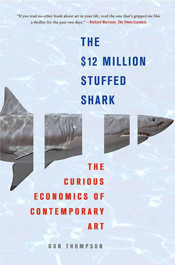The $12 Million Stuffed Shark: The Curious Economics of Contemporary Art

I absolutely loved this book.
It explains the world of contemporary art – who buys it, how it sells, and why it becomes valuable.
Lots of books seek to explain things like this, but they think they can do it through anecdotes and vignettes. The books spend each chapter focused on a person. They follow them around and try to elaborate the larger gestalt through osmosis. Like, if we get the “vibe” of this person’s world, we’ll understand the larger concept. (See The Big Necessity by Rose George, for example.)
This book does not do that. It was written by an economist. It explains – in precise, unadorned detail – how the contemporary art market works. I discuss all the players:
- Artists
- Art galleries
- Art dealers
- Art auctions
- Art fairs
- Art collectors
All of those play a part in the market. The book explains the motivations behind each one, and how they contribute to the larger market.
It turns out that contemporary art is a classic case on manufactured desire, and working one’s way up the ladder.
An artist gets picked up by a gallery. That gallery may be big or small, but it agrees to show and sell the artists work for half of the sale price. The artist gets “branded” by the gallery as being in their “stable.” Eventually, the artist gets purchased by a known collector. This further signals to the market that their work is important.
Eventually dealers and consultants start recommending the artist to their collector clients. The gallery or dealer might start showing their work at art fairs.
At some point, their work comes up for auction in the secondary market, which is where the real money is made. Often, the auction is “rigged” – the auctioneers produces “chandelier bids” (fictitious bids that “came from the chandelier”) to work the price up. If it doesn’t sell, they claim it “didn’t meet its reserve.”
The entire process is orchestrated. And it’s not sinister – I think the wealthy people involved know that the whole thing is wildly subjective, but they play along because something becomes worth what they say it’s worth.
It reminded me of Ashley Mears’ book Very Important People, about the high-end club scene. The art world can be the same way. It’s an insular world of people who are – in some senses – just celebrating their own wealth. They know that an artwork has no intrinsic value, especially contemporary art (defined as art since 1970) which isn’t in short supply and can seemingly be created at will.
I think, at some level, the wealthy people in the art world just want to convince themselves of their own taste. They want to say they paid $10 million for a painting because that belies some worth or value in their own judgment. If they spent the money, then their opinion has to be worth that, right?
Wonderful book. Refreshingly straightforward and informative.
Book Info
- I have read this book. According to my records, I completed it on .
- A softcover copy of this book is currently in my home library.